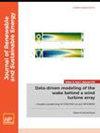Methane catalytic cracking by solid materials and molten media for hydrogen production: A review
IF 1.9
4区 工程技术
Q4 ENERGY & FUELS
引用次数: 0
Abstract
Excessive emission of carbon dioxide is the leading cause of global warming. Hydrogen has the advantages of high calorific value and zero carbon emissions. It is considered an ideal energy to solve the problem of global warming, so the demand for hydrogen is increasing yearly. Due to economic considerations, methane is the main raw material for hydrogen production. Currently, 48% of the world's hydrogen comes from steam methane reforming. However, this process needs to burn some methane for heating, generating carbon dioxide emissions simultaneously. In order to avoid carbon emissions from hydrogen production, there is an urgent need to develop new methods to produce hydrogen from methane. Because the carbon generated from direct methane cracking exists in solid form while not as carbon dioxide, the direct methane cracking process for hydrogen production has become a hot research topic in recent years. In this paper, a comprehensive review of the research related to catalytic methane cracking for hydrogen production is presented, especially the research on catalytic cracking of methane using solid materials or molten metal media as catalytic media is summarized in detail. Next, a brief overview of the mechanism of catalytic methane cracking for hydrogen production and the characteristics of the generated carbon as a by-product are presented. Finally, the catalytic cracking of methane in molten media or solid materials and the research trend were prospected.利用固体材料和熔融介质催化裂解甲烷制氢:综述
二氧化碳的过度排放是全球变暖的主要原因。氢气具有高热值和零碳排放的优点。它被认为是解决全球变暖问题的理想能源,因此对氢的需求逐年增加。出于经济方面的考虑,甲烷是制氢的主要原料。目前,全球 48% 的氢气来自甲烷蒸汽转化。然而,这一过程需要燃烧部分甲烷进行加热,同时会产生二氧化碳排放。为了避免制氢过程中的碳排放,迫切需要开发新的甲烷制氢方法。由于直接甲烷裂解产生的碳是以固体形式存在,而不是以二氧化碳形式存在,因此直接甲烷裂解制氢工艺成为近年来的研究热点。本文全面综述了催化甲烷裂解制氢的相关研究,特别是详细总结了以固体材料或熔融金属介质为催化介质的甲烷催化裂解研究。接着,简要介绍了催化甲烷裂解制氢的机理以及副产品碳的特性。最后,展望了在熔融介质或固体材料中催化裂解甲烷及其研究趋势。
本文章由计算机程序翻译,如有差异,请以英文原文为准。
求助全文
约1分钟内获得全文
求助全文
来源期刊

Journal of Renewable and Sustainable Energy
ENERGY & FUELS-ENERGY & FUELS
CiteScore
4.30
自引率
12.00%
发文量
122
审稿时长
4.2 months
期刊介绍:
The Journal of Renewable and Sustainable Energy (JRSE) is an interdisciplinary, peer-reviewed journal covering all areas of renewable and sustainable energy relevant to the physical science and engineering communities. The interdisciplinary approach of the publication ensures that the editors draw from researchers worldwide in a diverse range of fields.
Topics covered include:
Renewable energy economics and policy
Renewable energy resource assessment
Solar energy: photovoltaics, solar thermal energy, solar energy for fuels
Wind energy: wind farms, rotors and blades, on- and offshore wind conditions, aerodynamics, fluid dynamics
Bioenergy: biofuels, biomass conversion, artificial photosynthesis
Distributed energy generation: rooftop PV, distributed fuel cells, distributed wind, micro-hydrogen power generation
Power distribution & systems modeling: power electronics and controls, smart grid
Energy efficient buildings: smart windows, PV, wind, power management
Energy conversion: flexoelectric, piezoelectric, thermoelectric, other technologies
Energy storage: batteries, supercapacitors, hydrogen storage, other fuels
Fuel cells: proton exchange membrane cells, solid oxide cells, hybrid fuel cells, other
Marine and hydroelectric energy: dams, tides, waves, other
Transportation: alternative vehicle technologies, plug-in technologies, other
Geothermal energy
 求助内容:
求助内容: 应助结果提醒方式:
应助结果提醒方式:


